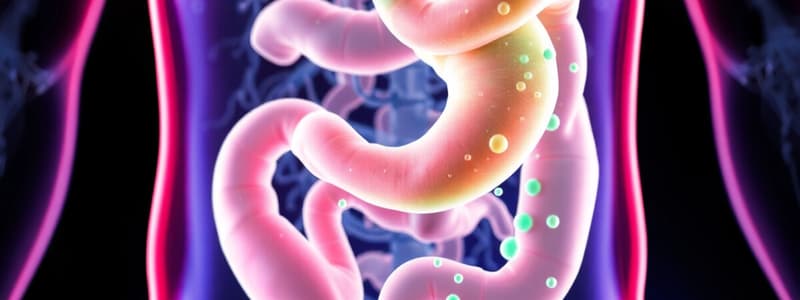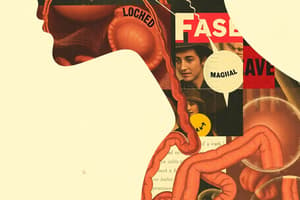Podcast
Questions and Answers
What is the average daily secretion of saliva?
What is the average daily secretion of saliva?
- 2000-2500 mL
- 800-1500 mL (correct)
- 1500-2000 mL
- 500-800 mL
Which of the following is NOT a function of saliva?
Which of the following is NOT a function of saliva?
- Moistens the mouth
- Inhibits bacterial growth
- Acts as a digestive buffer
- Provides nutrients to teeth (correct)
Which gland is primarily responsible for producing serous secretion?
Which gland is primarily responsible for producing serous secretion?
- Submandibular glands
- Parotid glands (correct)
- Smaller mucosal glands
- Sublingual glands
What is the pH range of saliva?
What is the pH range of saliva?
Which enzyme in saliva helps initiate starch digestion?
Which enzyme in saliva helps initiate starch digestion?
What substance in saliva is responsible for killing bacteria?
What substance in saliva is responsible for killing bacteria?
Which salivary gland is NOT a major salivary gland?
Which salivary gland is NOT a major salivary gland?
What type of reflex triggers the secretion of saliva during food stimulation?
What type of reflex triggers the secretion of saliva during food stimulation?
Which of the following ions is present in high concentration in saliva?
Which of the following ions is present in high concentration in saliva?
Which component in saliva helps lubricate food for easier swallowing?
Which component in saliva helps lubricate food for easier swallowing?
What is the primary function of acetylcholine in the enteric nervous system?
What is the primary function of acetylcholine in the enteric nervous system?
Which neurotransmitter is primarily responsible for inhibitory effects in the gastrointestinal tract?
Which neurotransmitter is primarily responsible for inhibitory effects in the gastrointestinal tract?
What role do the sympathetic fibers play in gastrointestinal function?
What role do the sympathetic fibers play in gastrointestinal function?
Which statement about the enteric nervous system is true?
Which statement about the enteric nervous system is true?
How does the sight of appealing food influence the digestive system?
How does the sight of appealing food influence the digestive system?
Which statement best describes the composition of enteric neurons?
Which statement best describes the composition of enteric neurons?
What effect does parasympathetic stimulation have on gastrointestinal functions?
What effect does parasympathetic stimulation have on gastrointestinal functions?
What type of neurons predominantly secrete acetylcholine in the digestive system?
What type of neurons predominantly secrete acetylcholine in the digestive system?
What happens to intestinal motility when norepinephrine is released?
What happens to intestinal motility when norepinephrine is released?
What is the relationship between the enteric nervous system and the central nervous system?
What is the relationship between the enteric nervous system and the central nervous system?
What is the primary function of the myenteric plexus?
What is the primary function of the myenteric plexus?
Which statement accurately describes the submucosal plexus?
Which statement accurately describes the submucosal plexus?
What type of neuron structure is primarily found in the submucosal plexus?
What type of neuron structure is primarily found in the submucosal plexus?
Which of the following is NOT controlled by the myenteric plexus?
Which of the following is NOT controlled by the myenteric plexus?
The enteric nervous system is primarily confined within which structure?
The enteric nervous system is primarily confined within which structure?
Which part of the gastrointestinal tract does the myenteric plexus extend from?
Which part of the gastrointestinal tract does the myenteric plexus extend from?
How does the myenteric plexus influence gastrointestinal movements?
How does the myenteric plexus influence gastrointestinal movements?
What is one primary role of the enteric nervous system?
What is one primary role of the enteric nervous system?
Which mechanism is primarily influenced by the submucosal plexus?
Which mechanism is primarily influenced by the submucosal plexus?
What type of nerve fibers predominantly compose both the myenteric and submucosal plexuses?
What type of nerve fibers predominantly compose both the myenteric and submucosal plexuses?
Flashcards
Enteric Nervous System
Enteric Nervous System
A network of neurons within the gut wall that controls digestive functions.
Peristaltic Waves
Peristaltic Waves
Waves of muscle contractions that move food along the digestive tract.
Excitatory Neurons
Excitatory Neurons
Nerve cells that release chemicals to stimulate a response.
Inhibitory Neurons
Inhibitory Neurons
Signup and view all the flashcards
Acetylcholine
Acetylcholine
Signup and view all the flashcards
Norepinephrine
Norepinephrine
Signup and view all the flashcards
Autonomic Nervous System
Autonomic Nervous System
Signup and view all the flashcards
Parasympathetic Nervous System
Parasympathetic Nervous System
Signup and view all the flashcards
Sympathetic Nervous System
Sympathetic Nervous System
Signup and view all the flashcards
Autonomic Function of the Enteric Nervous System
Autonomic Function of the Enteric Nervous System
Signup and view all the flashcards
Myenteric Plexus (Auerbach's Plexus)
Myenteric Plexus (Auerbach's Plexus)
Signup and view all the flashcards
Submucosal Plexus (Meissner's Plexus)
Submucosal Plexus (Meissner's Plexus)
Signup and view all the flashcards
Increased Intensity and Rate of Contractions
Increased Intensity and Rate of Contractions
Signup and view all the flashcards
Increased Velocity of Contractions
Increased Velocity of Contractions
Signup and view all the flashcards
Increased Muscle Tone
Increased Muscle Tone
Signup and view all the flashcards
Local Intestinal Secretion
Local Intestinal Secretion
Signup and view all the flashcards
Local Absorption
Local Absorption
Signup and view all the flashcards
Local Contraction of Submucosal Muscle
Local Contraction of Submucosal Muscle
Signup and view all the flashcards
Intercommunicating Nerve Plexus
Intercommunicating Nerve Plexus
Signup and view all the flashcards
Peristaltic Movements
Peristaltic Movements
Signup and view all the flashcards
Secretory Functions
Secretory Functions
Signup and view all the flashcards
Gastro-intestinal reflex pathway
Gastro-intestinal reflex pathway
Signup and view all the flashcards
Parotid gland
Parotid gland
Signup and view all the flashcards
Submandibular Gland
Submandibular Gland
Signup and view all the flashcards
Sublingual gland
Sublingual gland
Signup and view all the flashcards
Salivary amylase
Salivary amylase
Signup and view all the flashcards
Lingual lipase
Lingual lipase
Signup and view all the flashcards
Aqueous fluids
Aqueous fluids
Signup and view all the flashcards
Mucin
Mucin
Signup and view all the flashcards
Study Notes
GIT & Saliva
- The gastrointestinal (GIT) tract and saliva are topics for study.
- Objectives include differentiating between mesenteric and submucosal plexuses, explaining the autonomic nervous system's role in GIT function, and discussing saliva composition and secretion mechanisms.
- The enteric nervous system is entirely within the GIT wall.
- The system extends from the upper esophagus to the internal anal sphincter.
- It's composed of two plexuses: the myenteric (Auerbach's) and submucosal (Meissner's) plexuses.
- Both plexuses comprise intricate networks of fine, unmyelinated nerve fibers and neuronal cell bodies forming ganglia.
Enteric Nervous System
- The myenteric plexus (Auerbach's plexus) lies between the outer longitudinal and inner circular smooth muscle layers and extends from the upper esophagus to the anus.
- It's principally responsible for controlling gastrointestinal movements.
- Its neurons are multipolar.
- The submucosal plexus (Meissner's plexus) lies between the inner circular smooth muscle and the muscularis mucosae, also extending from the stomach to the anus.
- It primarily regulates gastrointestinal secretions and local blood flow.
- This plexus's neurons are bipolar or unipolar (sensory) and multipolar (interneurons).
Neurotransmitters
- Enteric neurons release a variety of neurotransmitters.
- Acetylcholine (ACh) is a key neurotransmitter, generally acting as an excitatory signal, stimulating smooth muscle contraction and increasing intestinal secretions.
- Norepinephrine (NE), derived from extrinsic sympathetic neurons, usually has an inhibitory effect, opposing ACh's actions.
Role of the Autonomic Nervous System
- The enteric nervous system functions autonomously but needs communication with the central nervous system.
- Parasympathetic and sympathetic fibers connect with the CNS and/or the enteric nervous system to affect the GIT.
- This connection allows signals from outside the digestive system to influence it, like the sight of food stimulating stomach secretions.
- Sympathetic stimulation usually inhibits GIT function and constricts blood vessels. Conversely, parasympathetic stimulation promotes digestive activity.
- The autonomic system modulates the enteric nervous system's activities in most cases.
Saliva
- Saliva is mostly water (approximately 99%), with a pH of 6.8–7.0.
- Important components include salivary amylase (for starch digestion), lingual lipase (activated by stomach acid to digest fat), mucus (lubrication and binding), lysozymes (antibacterial), and IgA (also antibacterial).
- Electrolytes like sodium, potassium, chloride, phosphate, and bicarbonate ions are present.
- Average daily saliva production is around 1000 mL.
Salivary Glands
- The main salivary glands are parotid, submandibular, and sublingual.
- Smaller glands are also located in the mouth's mucosa.
- Saliva has a critical role in oral health:
- Moisten the mouth.
- Digest starches and fat.
- Cleanse the teeth.
- Inhibit bacterial growth.
- Dissolve molecules for taste.
- Dilute and buffer food.
- Moisten food & bind particles for swallowing
Saliva Secretion
- The major types of secretion in saliva include aqueous (serous) fluid containing water, ions, and digestive enzymes like ptyalin.
- The serous part is produced by the parotid, submandibular, and sublingual glands.
- Mucin-rich saliva (mucous secretion) is mainly created by the submandibular and sublingual glands.
- Parasympathetic signals are primary drivers of saliva production.
Simple and Conditioned Reflexes
- Simple reflexes involve direct stimulation within the oral cavity (e.g., food presence), triggering salivation.
- Conditioned reflexes (like mouth-watering from the smell of food) are associated with acquired responses.
Saliva Characteristics
- Aqueous fluids are also called serous secretions. These fluids contain water, ions and enzymes.
- Mucous secretions are rich in mucin.
Studying That Suits You
Use AI to generate personalized quizzes and flashcards to suit your learning preferences.




